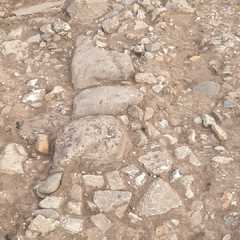Basic Information
- Approx NNW-SSE and ENE-WSW aligned corner of a structure in TR2W
Contexts
Narrative
-
- This feature represents the foundations of an approx NNW-SSE wall that may return a corner at a right angle to the ENE-WSW. There is also a possibility that the wall continues on towards the NNW in a very truncated state in the form of rubble deposit (2399), though this has yet to be proven. The wall itself was constructed using a drystone technique and consists of large unworked facing boulders with a rubble core in between. Some of the facing boulders have been robbed away and the wall itself has been truncated by numerous later features - most notably stone lined drainage channel F724 (although it is feasible the channel was incorporated into the wall, this is thought unlikely at this stage). The wall also appears not to truncate any other features and is constructed upon a yellowish/orangey sand levelling/foundation layer above the natural. This suggests the wall must be stratigraphically one of the earliest features on site and exists in close proximity to a series of other stratigraphically early walls (F722, F725, F726), although all of these walls are of a different form and character so they may not all be contemporary. Directly beneath one of the facing boulders, a small piece of Samian pottery was discovered. This alone could be residual, but a C14 date from a piece of animal bone discovered in the initial stone foundations of the wall could help to refine the construction date. If the two dates agree, there is the possibility that this wall represents a pre-monastic stone built structure on the island that may be as early as the Romano-british period.
-
- Ben Swain
- 24-10-2022
Dating Narrative
- No Interpretations
